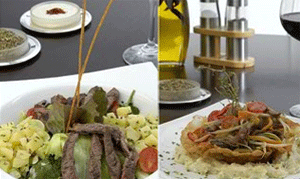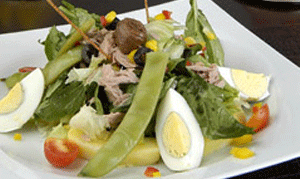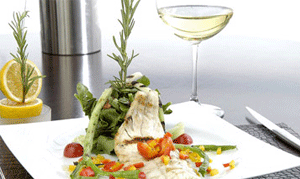Sephardic Cuisine
- Written by Admin TOA
- Published in Culture & Art

By Viki Koronya - -
Sephardic Jew brought along with them from Spain not only their customs and practices but also their cuisine. Going through a number of changes over the generations, these traditions are left to us as an inheratence. The changing conditions of life have caused them to begin to disappear. In our time, less time is spent in the kitchen. For example, instead of first boiling a certain food and, then, broiling or baking it in the oven, simpler dishes, such as a salad and grilled meat, are preferred.
Our eating habits are changing, and the Sephardic cuisine, which is much richer, is taking a secondary place on our tables. The cooking of Sephardic dishes require very careful and time-consuming work. Certain dishes are prepared by firstly picking the vegetables and boiling them; and, then, followed by their being braised and cooked.
For instance: Albondigas de Prasa (Turkish leek meatballs)
1.5 kg leeks (3.3 lb)
250 grams ground meat (8.8 oz)
1 slice of bread crumb (soaked)
1 egg
Salt and pepper
Trim and wash the leeks and cut them into pieces, then boil them until they are very soft. Drain, and when the vegetables are cool enough to handle, press them between your palms as hard as you can to get all the water out that you possibly can. Now put the leeks, bread crumb, meat and egg into the food processor with about 1 tsp of salt and pepper and blend to a soft paste. Shape into little round flat cakes and pan-fry in oil, turning them over once. Drain on kitchen paper and serve hot.

In Sephardic cuisine, there are a greater number of vegetable dishes in comparison to meat dishes. We suppose that this is due to worries about remaining faithful to the rules of keeping kosher. In order for the meat to be declared kosher, the animal must be inspected by those who are coreligionists and educated.
The animal is killed by a trained Jewish butcher without pain as they use a very special, sharp, and smooth knife and strike only once. Later, the internal organs of the animal are inspected one by one. If healthy, it is sold to the butcher shops that only sell kosher meat. Since eating the blood of the meat is forbidden in Judaism, the meat is taken through another process in the houses before it is cooked. This process involves washing the meat carefully and letting it sit in salted water for nearly an hour. This way, the pouring out of the blood is made possible. Once it is made sure that the meat is well cleaned, it is cooked. Meat and milk can not be cooked together. This is a religious rule.
Among the other characteristics of the Sephardic cuisine that we can point out is the usage of multiple vegetables. Eggplant and zucchini could be used together in pastries. Onion, tomato, parsley, and lemon are used very often in order to add flavors. From different parts of a vegetable, different dishes may be cooked. For example, a dish could be prepared by using the inside of a zucchini and another by using its skin. While a certain kind of dish may be made from spinach leaves, a different kind may be made from spinach stems. There is a ‘plum sauce’, which is called ‘agristida’, that is one of the main ingredients in the this cuisines.
Agristida: Water, lemon, oil, and salt are boiled together. Flour is dissolved in a small amount of cold water in a separate cup and added to the boiling water. When the mixture reaches a creamy stage, it is taken away from the heat, and a whipped egg is gradually added into it. This sauce is mainly used with grilled meat patties, boiled fish, and boiled brains.
KINDS OF ‘BOREK’
This cuisine has various, rich kinds of ‘borek’ (a kind of pastry). The different kinds of borek, made by rolling out dough, may be prepared with various vegetables and meat. Among the ones that are prepared by rolling dough, the ‘boreka’ is the most typical one. The ‘borekas’ may be stuffed with different ingredients such as cheese, eggplant, and potato. It could be claimed that the ones that are stuffed with eggplants are the most delicious ones.
And the recipe for it is the following:
Ingredients for the dough: 1 cup of sunflower oil, 1 cup of melted margarine, 1 cup of water, a pinch of salt, flour needed.
Ingredients for the stuffing: 2 eggplants, 100 grams feta cheese, 1 cup of grated kosher or Gruyere cheese.
Instructions: The eggplants are cooked over hot ashes; then, they are peeled, washed, and drained. The egglants are then blended very well in the blender and the cheeses are added into it. The ingredients for the dough are mixed together and it is kneaded until it reaches the thickness of an ear lobe. The dough is then rolled out with the rolling pin; the eggplant stuffing is spread over it and it is covered with dough. The pastries are given the form of a half-moon by using a coffee cup to press out the shapes. They are placed on a pan and whipped egg is spread over them. Grated cheese is sprinkled over them and they are baked in the oven.
The vegetable boreks: Ençusa de espinaka (with spiniah), Ençusa de Berencene (with eggplant), Almodrote de Kalavasa (with zucchini).
Encusa de espinaka: The spinach leaves of are washed and chopped finely. After this dries, bread crumbs, eggs, feta cheese, kosher cheese, sunflower oil, and salt are added and the mix is kneaded. This mixture is spread over an oiled pan and it is cooked in the oven after grated cheese is sprinkled over it.

HOLIDAY FOOD
We should mention a little about the holiday foods. (Friday evenings and Saturday days are considered holidays). In every Jewish household, Friday evenings have a special place. In general, there is a big family dinner. Youngsters gather in the homes of the elderly. The host looks after Friday evenings with great care.
The table is prepared elegantly. There is a special way of table preparation: white table cloth, the Shabbat candle, Kiddush glass, a whole loaf of bread, and flowers are used.
The menu is different from that of other evenings of the week. A few kinds of borek and fish (mostly ‘Gaya Kon Avramila’ with the ‘plum sauce’) are the general dishes of these evenings.
We cannot go on without providing the recipe of the ‘plum sauce’: Sour plums are washed and boiled; after they are drained, they are squeezed through the strainer until their pulp is left over. The pulp is then cooked in a pan along with oil, sugar, salt, and a bit of water. When it begins to boil, the fish is placed in it and cooked for about ten minutes.
During the Friday dinners, after the fish, meat or chicken, a few types of vegetables, and rice are brought to the table. After this wonderful dinner, various types of desserts are eaten. On Saturdays, the males of the household go to the morning prayers. The women, on the other hand, prepare a grand breakfast for the men when they return. This is called ‘dezayuno.’
On the table, there would be bulemas (‘rose boreks’ that are made of phyllo and stuffed with eggplant, spinach, or cheese), borekas, tapadas (a pan borek that is made of dough), biskocos (biscuits), boiled eggs, various kinds of cheese, watermelon, and grapes.
Among the important holidays, there is ‘Rosh Hashanah’ (New Year’s Eve in the Hebrew calender). This holiday is celebrated in the month of September and out-of-season fruits and vegetables are eaten throughout. Also on the table would be the leek patty, for which we gave the recipe earlier, spinach borek, fish, chicken or meat, vegetables, pumpkin pie, apple jam, pomagranates, dates, and wine.
Immediately after this holiday, the ‘Yom Kippur Fasting’ is practiced. Throughout the fast, which lasts twenty six hours, nothing is eaten or drunk. Prior to the fast, a full course meal, without spices, is eaten. The fast is broken by eating small loaves of bread that are dipped in oil. Following this, coffee with milk is drunk and sweet and salty biscuits are eaten. After taking a short break, vermicelli soup with chicken is eaten. Another holiday celebrated by Jews is ‘Pesach’ (Passover), which is symbolized with a diet excluding leavening. The families gather around the table for the meal named a ‘seder.’ Before the seder, the story of the Jews’ escape from Egyptian captivity is read.
On the seder table, the following is placed symbolically: Matzoh (bread without leavining), a leg of lamb (the sacrifice), hard-boiled eggs, celery leaf, charoset (a kind of spread prepared with grapes or dates; it sybolizes the mixture used in construction during the time of captivity), and vinegar.
The meal, on the other hand, includes the following: densely boiled egg ‘bimuelos’ (boreks that are prepared without leavening), ‘fritadas’ (boreks with vegetables), fish, and lamb meat.
The desserts that are special to this holiday are these; Marzipan (almond spread), Sarope blanko (white dessert), ‘tez pisti’ (a dessert with walnuts).
Passover lasts for about a week. Only home-cooked meals are eaten. For this reason, this is a quite tiring holiday for the women. Sepharidic Jews settled in various parts of Turkey. Primarily, Bursa, Izmir, Canakkale, Tekirdag, Edirne, and Istanbul are the cities they live in. The cuisine of each region has its own characteristics. While same dishes could be named differently according to the region, dishes that have the same name could be prepared with different methods in different places.
Currently, the Levi Restaurant, which is located behind the Istanbul Egyptian Bazaar, serves Sephardic food; it has provided service, especially to Jewish businessmen, for years.
* This text has been taken from the September-October 2003 - 56th issue of the ‘Gorus Magazine’ of TUSIAD.
A KOSHER RESTAURANT IN ISTANBUL
Levi Lokantası
Tahmis Kalçın Sok. Çavuşbaşı Han No: 23/6 Eminönü, İstanbul
Tel: +90212 5121196
Fax: +90212 5126437
Latest from Admin TOA
- Dünya Enerji Konseyi Avrupa Bölgesel Toplantısı İstanbul’da Gerçekleşti
- Retrial Ordered in Fraud Case Against Turkish-American Businessman Yalçın Ayaslı
- From a Bag Stand in Connecticut to a 40,000 Square Foot Warehouse in New Jersey: Ali Dayı's Entrepreneurial Journey
- Hiram & Solomon Cigars Introduces the Patriot Cigar Honoring M.W. George F. Hamilton, 91st Grand Master of Masons in Massachusetts
- PCA Officially Announces 2025 Trade Show Dates
